Epithet after epithet was found too weak to convey to those who have not visited the intertropical regions, the sensation of delight which the mind experiences . . .
Charles Darwin – Voyage of the Beagle
My days at the Explorama venues were comprised of a wonderfully satisfying mixtu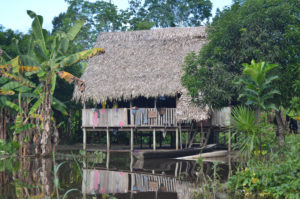 re of early morning birding, explorations upon their myriad rainforest trails, travel upon the rivers by dugout canoe, hours up on the canopy walkway, and a constant influx of fresh information regarding tropical rainforest biology. Exposure to the cultures of the tribal folks and riberenos people who lived along the rivers added to the store of awareness I was accumulating. It was an experiential learning affair of the finest kind.
re of early morning birding, explorations upon their myriad rainforest trails, travel upon the rivers by dugout canoe, hours up on the canopy walkway, and a constant influx of fresh information regarding tropical rainforest biology. Exposure to the cultures of the tribal folks and riberenos people who lived along the rivers added to the store of awareness I was accumulating. It was an experiential learning affair of the finest kind.
Naturally, the first thing to be noticed when entering the tropical rainforest is the vegetation itself. Some of the plants would appear familiar to you. After all, plants adapted for living in the low light conditions of the  rainforest floor make ideal house plants. Dieffenbachia, Coleus, Sansevieria (e.g. mother in-law’s tongue), and Philodendron are a few such plants. But the rainforest is arranged in complex layers – ground layer, herbaceous layer, understory layer, canopy layer, and emergent layer. As a result, the forest presents itself in a complex of thousands
rainforest floor make ideal house plants. Dieffenbachia, Coleus, Sansevieria (e.g. mother in-law’s tongue), and Philodendron are a few such plants. But the rainforest is arranged in complex layers – ground layer, herbaceous layer, understory layer, canopy layer, and emergent layer. As a result, the forest presents itself in a complex of thousands  of plant species arranged in a spectacularly intricate assemblage. Pablo introduced me to a bewildering array of palms, a baffling collection of tree species whose leaves all seemed remarkably similar in appearance, and an abundance of plants both woody and herbaceous having medicinal properties. How could I ever hope to know all of these? I found myself experiencing sensory overload as I struggled to recall and identify at least a few of the more common species.
of plant species arranged in a spectacularly intricate assemblage. Pablo introduced me to a bewildering array of palms, a baffling collection of tree species whose leaves all seemed remarkably similar in appearance, and an abundance of plants both woody and herbaceous having medicinal properties. How could I ever hope to know all of these? I found myself experiencing sensory overload as I struggled to recall and identify at least a few of the more common species.
Obviously this intricate collection of plant species and heterogeneous layering forms a nearly infinite matrix of ecological niches. The result of this is, of course, a nearly boundless collection of animals which have evolved to fill these niches. Thus we see the tremendous biodiversity among the Animalia typical of a tropical rainforest.
Typically it is the insects which one first notices. They are present in tremendous numbers; by one estimate some 70 000 species may occupy a single acre of rainforest. The actual number is difficult to pinpoint. There is much research yet to be done on rainforest biodiversity and new species are discovered every year. In thinking about why there are so many kinds of 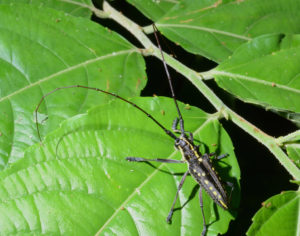 insects here, one might consider the movie Honey I Shrunk the Kids. This was an adventure/comedy in which the children are reduced to the size of insects. Ponder what it would be like to be the size of an ant. Think of the thousands of tiny nooks and crannies one might be able to occupy by having such a tiny body size. Consider how many places, unavailable to an organism the size of a human, would be accessible for hiding, nesting, feeding, and escaping predators. Even for animals the size of an average mammal (i.e. house cat-sized), the complex composition and layering of the rainforest provides for boundless microhabitats in which to live.
insects here, one might consider the movie Honey I Shrunk the Kids. This was an adventure/comedy in which the children are reduced to the size of insects. Ponder what it would be like to be the size of an ant. Think of the thousands of tiny nooks and crannies one might be able to occupy by having such a tiny body size. Consider how many places, unavailable to an organism the size of a human, would be accessible for hiding, nesting, feeding, and escaping predators. Even for animals the size of an average mammal (i.e. house cat-sized), the complex composition and layering of the rainforest provides for boundless microhabitats in which to live.
Ants seem to be everywhere, and in astounding numbers to boot. It has been suggested that there are tens of trillions of ants for each person on earth. Having once lived for several years in tropical Southeast Asia, I can attest to their omnipresence. Coffee shops often had the legs of their pastry cabinets sitting in small cups of water. These served as moats to prevent ants from climbing upward and devouring the contents of the cabinet. In our house, it was not unusual to find an ant’s nest between the pages of a magazine left lying about for too long. On one occasion, my wife and I bolted from our bed immediately after tucking in for the night. During the day, ants had erected a nest of impressive size in the space between the springs and mattress. They had exhibited their displeasure at being disturbed by swarming over us. Yes truly, ants are everywhere in the tropics. But, having discussed some of the tropical rainforest ants I find most interesting in a previous blog (9. Ever Thought Much About Ants?), I will leave them and turn to some of their interesting kin.
The Arthropoda is a phylum that contains not only insects but spiders, scorpions, centipedes, and millipedes (among others) as well. In fact, about 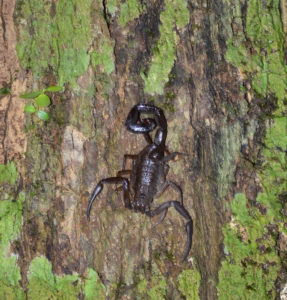 three-quarters of all the animal species in the world are arthropods. Arthropods seem to be the group most notable for bringing out apprehension in humans. It is the creeping, crawling things of the forest that almost universally give people the creeps. Admittedly, if one has a spider phobia, the tropical rainforest might present a challenge. Try to fortify yourself with the knowledge that these animals exhibit fascinating behaviors and their threat is often highly exaggerated. Some may have bites which are quite unpleasant but their danger is typically much overblown. Still, even as a professional zoologist, I must admit to requiring a substantial period of time to overcome a gnawing feeling of anxiety when it came to dealing with spiders.
three-quarters of all the animal species in the world are arthropods. Arthropods seem to be the group most notable for bringing out apprehension in humans. It is the creeping, crawling things of the forest that almost universally give people the creeps. Admittedly, if one has a spider phobia, the tropical rainforest might present a challenge. Try to fortify yourself with the knowledge that these animals exhibit fascinating behaviors and their threat is often highly exaggerated. Some may have bites which are quite unpleasant but their danger is typically much overblown. Still, even as a professional zoologist, I must admit to requiring a substantial period of time to overcome a gnawing feeling of anxiety when it came to dealing with spiders.
On my most recent trip to Amazonian Peru I was accompanied by my grandson. Since childhood he has also had an intense interest in natural history but, like many of us, exhibits a distinct unease around spiders. Naturally our first night-walk turned up a plethora of tarantulas. They are extremely common in the rainforest and they are indeed imposing. With a leg span of five or six inches and a heavy-bodied look, they seem to dwarf 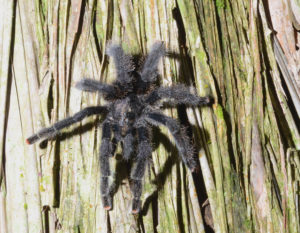 the spiders one typically sees in Indiana. Most were pink-toed tarantulas which could be seen lurking at the mouth of their burrow. Here they sat prepared to rush out in an instant and grab their hapless prey. Overcoming his hesitancy, Riley learned to use a tried and true method for getting a tarantula to emerge. Taking a short length of twig, he probed at the mouth of several of these ground burrows. Typically they are around two inches in diameter and are often occupied even when it does not appear so. Manipulating the twig at the burrow entrance will mimic the rustling about of a cricket or katydid. In doing this, he was often rewarded by having a previously unseen tarantula aggressively bolt out of its tunnel entrance. It was an entertaining game but not one recommended for the arachnophobe.
the spiders one typically sees in Indiana. Most were pink-toed tarantulas which could be seen lurking at the mouth of their burrow. Here they sat prepared to rush out in an instant and grab their hapless prey. Overcoming his hesitancy, Riley learned to use a tried and true method for getting a tarantula to emerge. Taking a short length of twig, he probed at the mouth of several of these ground burrows. Typically they are around two inches in diameter and are often occupied even when it does not appear so. Manipulating the twig at the burrow entrance will mimic the rustling about of a cricket or katydid. In doing this, he was often rewarded by having a previously unseen tarantula aggressively bolt out of its tunnel entrance. It was an entertaining game but not one recommended for the arachnophobe.
Perhaps the most interesting experience I’ve had with a tarantula actually occurred in Ecuador many years ago. Experiencing a midnight bathroom urge, I descended from our stilted cabana and walked to the nearby outhouse. It was quite nice as it had running water and lighting. Flipping on the switch, I noticed a stockpile of toilet paper sitting on top of the tank lid. There were several rolls and I was startled when I noticed that a large pink-footed tarantula had taken up residence in one of the cardboard tubes of a roll. Agreeing to a truce, I completed my work without further adventure. But it was the first time I had been obliged to pee while staring down a large, menacing looking arachnid -and one lurking inches from one of my most prized body parts at that.
In Peru, my grandson was on high alert for another species of spider of which he had read much. The Brazilian wandering spider is considered one of the more dangerous rainforest spider species. All spiders are venomous 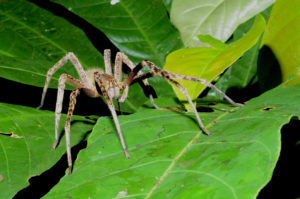 but this one has a particularly potent blend of toxic proteins in its venom. A dose of venom measuring in the thousandths of a gram can kill a mouse. A bite from a Brazilian wandering spider may cause a variety of alarming symptoms in humans including blood pressure changes, altered heart rhythm, cramping, convulsions, and blurred vision. Of course, as luck would have it, we soon ran across one during our night jaunt. As we played our lights about in our search for nocturnal creatures, we illuminated a large leaf projecting out at shoulder-height along the trail. There, sitting quietly on this elevated leaf, was the infamous wandering spider. It was certainly an intimidating looking fellow. Large bodied with legs spanning nearly six inches, this specimen did indeed have the look of a spider which projected the demand that it be granted some space.
but this one has a particularly potent blend of toxic proteins in its venom. A dose of venom measuring in the thousandths of a gram can kill a mouse. A bite from a Brazilian wandering spider may cause a variety of alarming symptoms in humans including blood pressure changes, altered heart rhythm, cramping, convulsions, and blurred vision. Of course, as luck would have it, we soon ran across one during our night jaunt. As we played our lights about in our search for nocturnal creatures, we illuminated a large leaf projecting out at shoulder-height along the trail. There, sitting quietly on this elevated leaf, was the infamous wandering spider. It was certainly an intimidating looking fellow. Large bodied with legs spanning nearly six inches, this specimen did indeed have the look of a spider which projected the demand that it be granted some space.
We admired the specimen from a respectful distance and I snapped some photos. As I did so, Riley nonchalantly reminded us of another most peculiar symptom of Brazilian wandering spider bite. Their venom contains a chemical that boosts blood flow such that male humans may experience priapism as a result of their bite. A priapism is an extended, painful period of erection – like the ones they warn about in Viagra commercials. This seemed another fine reason to avoid their bite. But, on a positive note, here was yet another example of the potential biopharmaceuticals which may reside undiscovered within the plants and animals of the tropical rainforest. Brazilian wandering spider venom is of interest to researchers studying potential treatments for erectile dysfunction in human males. All in all, it was a most fascinating spider encounter.
Another strange arachnid seen on our nocturnal walk was the tailless whip  scorpion. How intimidating these animals look. They would make a great science fiction monster. The genre of movies in which atomic radiation exposure has caused a normally harmless animal to grow to gigantic proportions would be a natural for them. Like other arachnids, whip scorpions have eight legs but the front pair has been greatly lengthened and serves as a pair of antennae. These creepily and stealthily probe ahead of them in their cunning search for prey. Certain of their mouthparts have been modified into a pair of long raptorial claws tipped with ghastly, spines. When close enough, these are rapidly thrust outward to grasp and immobilize their prey (usually smaller insects).
scorpion. How intimidating these animals look. They would make a great science fiction monster. The genre of movies in which atomic radiation exposure has caused a normally harmless animal to grow to gigantic proportions would be a natural for them. Like other arachnids, whip scorpions have eight legs but the front pair has been greatly lengthened and serves as a pair of antennae. These creepily and stealthily probe ahead of them in their cunning search for prey. Certain of their mouthparts have been modified into a pair of long raptorial claws tipped with ghastly, spines. When close enough, these are rapidly thrust outward to grasp and immobilize their prey (usually smaller insects). 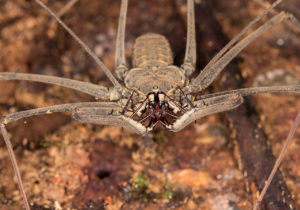 Whenever I see a tailless whip scorpion, I always find myself sympathizing with the hapless grasshopper or cricket which may soon find itself confronted by this miniature science fiction monster. Imagining oneself scaled down to their miniature world and confronted by one of these terrifying creatures is the stuff of nightmares.
Whenever I see a tailless whip scorpion, I always find myself sympathizing with the hapless grasshopper or cricket which may soon find itself confronted by this miniature science fiction monster. Imagining oneself scaled down to their miniature world and confronted by one of these terrifying creatures is the stuff of nightmares.
One could likely fill several books with stories about rainforest arthropod encounters. They are after all the most diverse group of animals on the planet. There are true scorpions having intensely painful stings to avoid. Tropical centipedes are notorious for the excruciating pain of their bites. There are walking sticks of giant size and even ones which jump like grasshoppers (jumping sticks) rather than slowly clamber about. Also to be seen are beetles the size of a newborn kitten, katydids which look just like leaves, and others that are carnivores instead of plant eaters. Everywhere are to be seen the nests, tunnels, and foraging columns of termites. This Lilliputian world is endlessly fascinating. But for now, I will leave the arthropods and consider another member of the rainforest bestiary whose reputation is notorious. But, is it well deserved?
I suppose just about everyone is aware that the waters of the South American rainforest are frequented by piranhas (of several species). I would also bet that many who know of the piranha consider it one of the most dangerous animals on the planet. It doesn’t help that much of what the average person learns about this fish comes from films such as the Piranha series. Quite entertaining I suppose but informative, not so much.
The piranha I have most often encountered in Peru is a species known as the red-bellied piranha. It is true that, as depicted in movies, this fish does in occur in schools or shoals as it is sometimes termed. This schooling behavior is thought to be used more for protection from predators than for launching mass attacks upon hapless prey however. Typically piranhas feed on insects, crustaceans, and other fish. They will scavenge larger prey such as wading birds, capybaras, and caimans. Personally, I have never seen one of the en masse feeding frenzies sometimes depicted in films. This is not to say that a human entering the water is immune from a bite. Luis, one of my Peruvian friends, showed me a fifty-cent piece-sized scar on his shin that resulted from a piranha nibble. He had gotten the bite when he was a youngster. At that time, he had an itching mosquito bite that he had been incessantly scratching. It was oozing a bit of blood and, when he went for a swim, a piranha had taken an exploratory nip at the spot.
I often saw riberenos children playing and bathing in the rivers and streams apparently without concern. One will quite commonly see adults bathing, brushing teeth, or cleaning household wares in the streams as well. Once a fellow visitor at Explorama told me that he had gone piranha fishing with some other tourists that day. While some of them fished from one side of the boat, others swam off the opposite side. I believe this is a good illustration of the overblown reputation of this beautiful fish. In fact, there are several other kinds of fish in the Amazon that alarm me much more. There are freshwater stingrays capable of delivering an excruciation “sting” with their tail spine. Shuffle your feet when wading in the shallows! The Amazon basin is home to the electric eel which can reach a length of several feet and supply a shock capable of stunning a human. Then of course there is the infamous candiru to consider. This small catfish species is infamous due to the legend that it is attracted to urine. As a result, should a person urinate in the water, a candiru may follow the urine stream, enter the person’s urethra, and become lodged there. Removal without surgery is virtually impossible due to the fish’s backward projecting spines. It appears that the legend of the candiru may be more fable than fact. One will find it quite difficult to find a record of a documented “attack” by this fish. Nevertheless, when entering the waters of the Amazon Basin, wearing swim trunks always seemed like a good idea to me.
I was hopeful that I might encounter the legendary piranha upon my initial trip to Peru. I was curious to see for myself whether their dangerously voracious reputation was deserved. So it was that I found myself delighted when one afternoon Pablo announced, “today we are going piranha fishing.”
As we set forth on our fishing expedition, we were equipped with short, stout wooden poles four or five feet in length and an inch in diameter. Tied to the end of each was a fishing line and attached to this was a lengthy leader of heavy wire connected to a large, barbed hook. The sharpness of the teeth of piranhas is no myth. Without the metal leader, hook and bait would quickly disappear. We used small chunks of beef as bait.
We fished from an open john-boat in a tributary channel of the Rio Napo. As 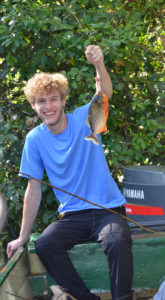 a child, I was often warned not to make too much noise in the boat. “You’ll scare the fish away”, my dad cautioned. You can imagine my surprise when Pablo and our boatmen, who was also fishing, periodically and vigorously slapped and stirred the water with the tip of their poles. This they said would mimic the thrashing of an ill or injured fish which would, of course, attract the piranhas.
a child, I was often warned not to make too much noise in the boat. “You’ll scare the fish away”, my dad cautioned. You can imagine my surprise when Pablo and our boatmen, who was also fishing, periodically and vigorously slapped and stirred the water with the tip of their poles. This they said would mimic the thrashing of an ill or injured fish which would, of course, attract the piranhas.
Almost immediately after lowering my bait into the water I felt my first nibble. Ah, this is going to be easy thought I. Wrong! Describing the teeth of a red-bellied piranha as razor-sharp is no exaggeration. Their ability to quickly nip off a piece of bait while avoiding the hook was frustratingly skillful. Time after time, I gave a violent yank on the little pole in an attempt to set the hook. Time after time, I was rewarded by the site of a naked fishhook dangling from the leader. I did eventually manage to land a couple of quite modestly sized piranhas. They were far short of their twelve inch or more potential. Still, they were big enough to eat and at dinner that night they appeared on my plate in companionship with the ever-present beans, rice, and plantains. Their taste was quite good; mild, not fishy at all, and reminded me much of catfish. Also accompanying the meal 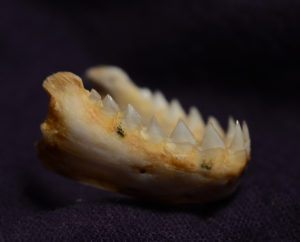 was a pair of lower mandibles. These had been carefully cleaned by Pablo and were presented to me as a souvenir. Ivory colored and sporting over a dozen triangular teeth of amazing sharpness, they serve today as reminders of a most unique and unforgettable fishing trip.
was a pair of lower mandibles. These had been carefully cleaned by Pablo and were presented to me as a souvenir. Ivory colored and sporting over a dozen triangular teeth of amazing sharpness, they serve today as reminders of a most unique and unforgettable fishing trip.
Photo Credits
close up of whipscorpion by Graham Wise at flickr.com
all other photos by the author
